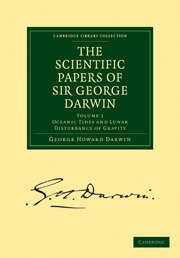Book contents
- Frontmatter
- PREFACE
- Contents
- Chronological List of Papers with References to the Volumes in which they probably will be contained
- PART I OCEANIC TIDES
- PART II THE LUNAR DISTURBANCE OF GRAVITY
- ART. 13 On an Instrument for Detecting and Measuring Small Changes in the Direction of the Force of Gravity
- ART. 14 The Lunar Disturbance of Gravity; Variations in the Vertical due to Elasticity of the Earth's Surface
- INDEX
- Plate section
ART. 13 - On an Instrument for Detecting and Measuring Small Changes in the Direction of the Force of Gravity
Published online by Cambridge University Press: 07 September 2010
- Frontmatter
- PREFACE
- Contents
- Chronological List of Papers with References to the Volumes in which they probably will be contained
- PART I OCEANIC TIDES
- PART II THE LUNAR DISTURBANCE OF GRAVITY
- ART. 13 On an Instrument for Detecting and Measuring Small Changes in the Direction of the Force of Gravity
- ART. 14 The Lunar Disturbance of Gravity; Variations in the Vertical due to Elasticity of the Earth's Surface
- INDEX
- Plate section
Summary
Account of the experiments.
We feel some difficulty as to the form which this report should take, because we are still carrying on our experiments, and have, as yet, arrived at no final results. As, however, we have done a good deal of work, and have come to conclusions of some interest, we think it better to give at once an account of our operations up to the present time, rather than to defer it to the future.
In November, 1878, Sir William Thomson suggested to me that I should endeavour to investigate experimentally the lunar disturbance of gravity, and the question of the tidal yielding of the solid earth. In May, 1879, we both visited him at Glasgow, and there saw an instrument, which, although roughly put together, he believed to contain the principle by which success might perhaps be attained. The instrument was erected in the Physical Laboratory of the University of Glasgow. We are not in a position to give an accurate description of it, but the following rough details are quite sufficient.
A solid lead cylinder, weighing perhaps a pound or two, was suspended by a fine brass wire, about 5 feet in length, from the centre of the lintel or cross-beam of the solid stone gallows, which is erected erected there for the purpose of pendulum experiments.
- Type
- Chapter
- Information
- The Scientific Papers of Sir George DarwinOceanic Tides and Lunar Disturbance of Gravity, pp. 389 - 429Publisher: Cambridge University PressPrint publication year: 2009First published in: 1907



